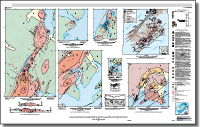Selected Geologic Maps of the Kodiak Batholith and Other Paleocene Intrusive Rocks, Kodiak Island, Alaska
Links
- Document: Pamphlet (500 KB pdf)
- Sheet: Sheet (7.5 MB pdf)
- Database: Database (31 MB zip)
- Metadata: Metadata (40 KB zip)
- Download citation as: RIS | Dublin Core
Abstract
Kodiak Island in southern Alaska is one of the premier examples globally for the study of forearc magmatism. This location contains two Paleocene intrusive belts that formed due to the subduction of a migrating spreading ridge and slab-window: the Kodiak batholith and the trenchward magmatic belt. These magmatic rocks are part of the Sanak-Baranof belt, which extends for greater than 2,100 km along the southern Alaskan margin and vary in age from 61 to 50 Ma west to east.
Trenchward-belt rocks, with an 40Ar/39Ar age of 60.2±0.9 Ma, intrude into the Paleocene Ghost Rocks Formation and are composed of granitoids, basaltic dikes, and small gabbroic plutons that lie along or southward of the Kalsin Bay Fault. Such intrusions were emplaced at shallow levels and have abundant evidence of incomplete intermingling of basaltic and granitic magmas. These textures indicate trenchward-belt intrusions that froze before complete assimilation, leaving behind features such as abundant locally stoped blocks, gabbroic pods within granitic intrusions, and microstructural evidence such as strongly embayed olivine and pyroxene phenocrysts in granitoid bodies.
The Kodiak batholith and satellite intrusions extend for over 110 km along the axis of Kodiak Island and vary in width from 2 to 6 km. These intrude into the Late Cretaceous Kodiak Formation. U-Pb ages on zircon from the intrusions range from 59.2±0.2 Ma in the southwest to 58.4±0.2 Ma near its northwest tip. We interpret these ages as tracking the location of a migrating triple junction and associated slab-window. The batholith is composed of granite and granodiorite, with lesser amounts of tonalite and diorite. The center of the Kodiak batholith contains high-inclusion zones with abundant residual host rock fragments that were carried up from 5–10 km below current exposure levels. These high-inclusion zones contain biotite aggregates, pure quartz clots, and large xenocrysts of sillimanite, kyanite, andalusite, and garnet. This is a higher-pressure mineral assemblage than exists in the batholith metamorphic aureole. Gravity observations and modeling are consistent with the high-inclusion zones extending downward for 5–10 km. The Kodiak batholith results from a migrating triple junction and slab-window that led to high degrees of partial melting within the Kodiak accretionary prism.
Suggested Citation
Farris, D.W., and Haeussler, P.J., 2020, Selected geologic maps of the Kodiak batholith and other Paleocene intrusive rocks, Kodiak Island, Alaska: U.S. Geological Survey Scientific Investigations Map 3441, pamphlet 10 p., scale 1:50,000, https://doi.org/10.3133/sim3441.
ISSN: 2329-132X (online)
Study Area
| Publication type | Report |
|---|---|
| Publication Subtype | USGS Numbered Series |
| Title | Selected geologic maps of the Kodiak batholith and other Paleocene intrusive rocks, Kodiak Island, Alaska |
| Series title | Scientific Investigations Map |
| Series number | 3441 |
| DOI | 10.3133/sim3441 |
| Publication Date | June 12, 2020 |
| Year Published | 2020 |
| Language | English |
| Publisher | U.S. Geological Survey |
| Publisher location | Reston, VA |
| Contributing office(s) | Alaska Science Center Geology Minerals |
| Description | Pamphlet: iv, 10 p.; Sheet: 61.25 x 38.79 inches; Database; Metadata |
| Country | United States |
| State | Alaska |
| Other Geospatial | Kodiak Island |
| Online Only (Y/N) | Y |
| Additional Online Files (Y/N) | Y |


